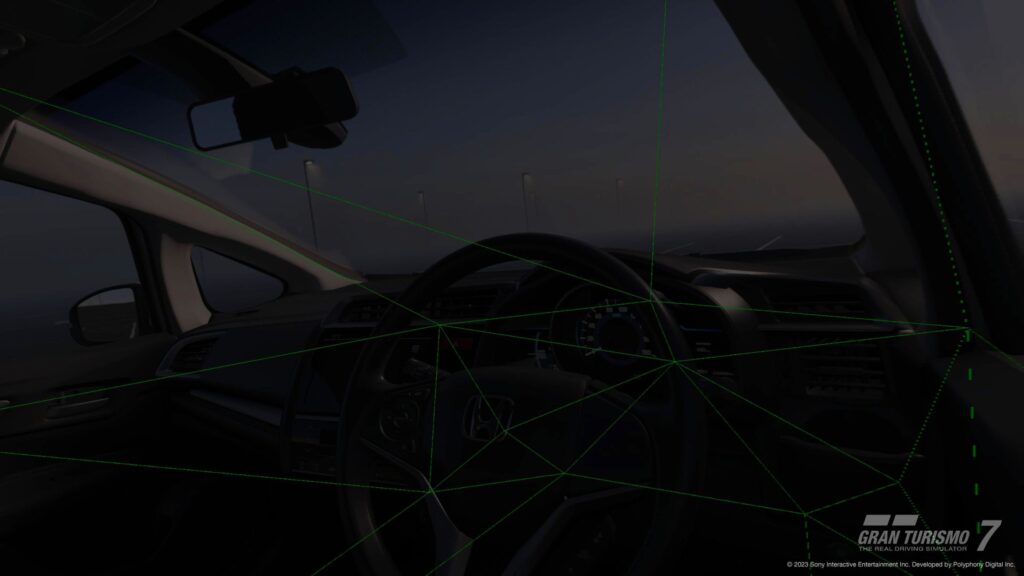Today, Sony is officially launching its PlayStation VR2 headset. It costs $550, and you can read our PSVR 2 review right here. But there are a few key experiences that Sony didn’t distribute to reviewers ahead of time — like a day-one patch for Gran Turismo 7 that makes almost the entire racing game playable in virtual reality.
I’m beginning to think that was a mistake, because GT7 is easily one of the best things I’ve tried in this headset, and I’m saying that having never played GT7 before. I’m certain a number of gearheads will buy a PlayStation VR2 for this game alone — and quite possibly a PS5, a steering wheel, and a set of pedals to go with it.
The game starts exactly the way it does on a flat screen TV. You adjust your screen settings and steering preferences, then get thrust into a mandatory minigame where you try to outrace the music by flinging a classic Porsche around a track.
Only you’re not looking at the car. Suddenly, you’re in the car, staring through the windshield of its detailed cockpit from the moment the race begins. Any time you drive a car in this game, you’re transported into the cockpit — a cockpit that’s doing some work.
The speedometer and tachometer function. You have depth perception — enough to preemptively brake instead of sliding off the track like I’ve done so many times before in racing games. I could genuinely use my rear view mirrors to spot rivals and block them from passing me. Sure, avid racing game fans can do that with traditional controls, but I’ve never felt comfortable doing it before.
And like other PSVR 2 games, GT7 takes advantage of eye-tracking foveated rendering to seamlessly increase the resolution in the spot you’re looking while decreasing it everywhere else. If you look closely, you can see it in action in the video above.
You can turn your head to gauge the distance between your vehicle and the cars you’re trying to pass, or wave goodbye to those you’ve already left in the dust. You can look down and watch your avatar’s arm row the gearbox if you pick a manual transmission, even if the game doesn’t let you reach out and grab that stick yourself. There’s enough readily accessible visual feedback that you could probably get away with turning off most of the UI for a pure driving experience. I did, and I’d like to remove even more:
(Note: I’m not sure there’s a good way to monitor tire wear in longer races without that UI, as I haven’t gotten that far in the campaign, but perhaps haptic feedback helps.)
There’s also VR “showroom” where you can view every vehicle you own (and any vehicle you can purchase) from any angle without racing at all. I was pleasantly impressed with the Honda Fit, a vehicle I’ve owned in real life, though it certainly could have been even more detailed.
Please know that the VR illusion definitely has flaws. The track and surrounding environs don’t look particularly well textured in VR. Rival cars often look like they’re blinking in and out of existence. The heavy rain splattering my windshield doesn’t seem to be coming from the sky — and left the inside of my Mazda Miata convertible completely dry. Speaking of convertibles: when I tried to stick my head out the open top, my entire car turned into an opaque black outline with an ugly wireframe inside.
(I also felt a slight lack of immersion when my FD’s pop-up headlights automatically popped themselves when I entered a tunnel. The 1995 Mazda RX-7 didn’t do that by itself… right?)
Oh, and I really can’t believe someone at Sony greenlit the current “VR Replay” you can watch after each race: it literally just teleports your disembodied viewer a few hundred feet along the racetrack, just far enough so you can watch your car shoot past, over and over and over again, with no replay controls whatsoever.
Gran Turismo series creator Kazunori Yamauchi claimed to GTPlanet that the game was designed for VR from day one. I have a hard time believing that given some of the design choices here, but one of those decisions has my utmost respect: the decision to automatically assume that if a player plugs in the VR headset, they want to be transported into a vehicle’s cockpit as if they were there. Even if I can see plenty of flaws, this is the only way I’d want to play this game from now on.
Here’s hoping Resident Evil Village and No Man’s Sky, the other flat PS5 games getting a PSVR 2 patch today, will be as compelling in VR as this one.

